Dateline: 10 April 2008
The evaporator is a pan that you put maple sap in and boil off the water. You boil until the sugar content is concentrated to maximum liquid sweetness, and the clear tree sap will turn some shade of maple syrup color.
You can purchase ready-made evaporator pans from maple syrup equipment suppliers. I think they are made of tin with soldered joints. They can be amazingly expensive.
In the book, Backyard Sugarin’ by Rink Mann, he suggests using a big, 18” by 24” “hotel lasagna pan” for an evaporator. Restaurant auctions might be a good source for getting such pans at a reasonable price. He also provides directions for making an evaporator pan out of a 30” by 32” piece of galvanized sheet metal. The sheet can be folded and hammered into shape without any soldering needed.
Using galvanized metal for a boiling pan doesn’t appeal to me. I opted to have a friend who is a welder make me a pan. It measures 16-1/2” wide by 33” long by 8” deep. It is made of stainless steel and has a drain on one end. Here is a picture:
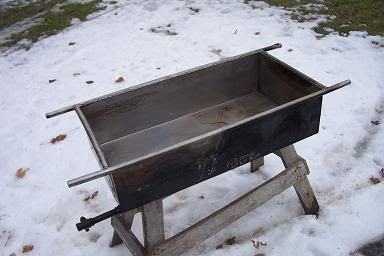
The metal in that pan came from a stainless steel plate that was screwed to one side of a swinging door inside a factory. I was doing some remodeling there and salvaged the metal before throwing out the door. I had no use for it at the time but knew it would come in handy someday.
My friend the welder happens to be a Backyard Sugarer too. He fabricated my evaporator pan, added the handles using some salvaged metal he had, welded in a threaded insert for the drain pipe, and charged me 40 bucks for the job.
The pan is pretty much indestructible. On one occasion I boiled too far and ended up with a tough, fired-on black residue in the bottom of the pan. Such an event would have totally ruined a fancy tin-and-solder evaporator pan. But not a stainless steel pan with welded corners. I took an electric disc sander to it and ground off the charred gunk. It took some doing but I did it. In between boiling batches of sap, I clean the pan with water and a sheet of 400-grit wet/dry sandpaper. You can’t beat stainless steel for durability and longevity
My pan sets on top of, and partly into, a firebox that I fabricated out of an old metal barrel, as shown in the picture below. By the way, in the picture you can see some charred sap inside the pan on the end. It is normal to get some of that after a boil and that's where the wet/dry sandpaper comes in real handy.

That fire-barrel is actually a new one made this year. The old one (just like it) rusted out after several seasons. My son, Robert made the new one using the old one as a pattern. The stabilizing framework of bolted-together metal conduit was still sound and he reused that. The chimney is 6” diameter stove pipe. It friction fits into a hole in the back of the barrel and is wired up as shown in this next picture:
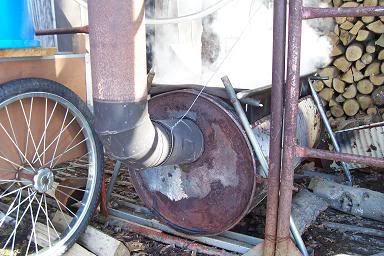
Here’s another view of the evaporator and firebox:

Those scrap pieces of metal in front of the firebox opening are used like a door to restrict airflow into the fire chamber as needed in order to maintain the hottest possible fire.
To use the evaporator we fill the pan with sap and build a fire in the firebox. We keep the sap a couple inches below the rim to allow for a rolling boil. It takes some time to get a fire hot enough to boil the pan’s contents. Once it starts to boil, we keep feeding the wood to it all day, and sometimes into the night. Here’s a picture of the firebox in action:
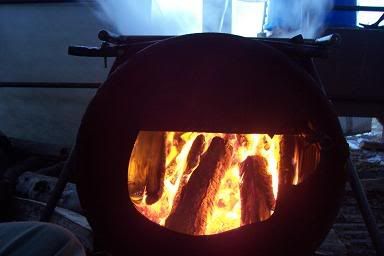
Boiling the sap down is a lot of fun (as long as you don’t boil it too far). The evaporator is located just outside a window in our house, so Marlene (who, with the kids, tends the fire when I’m at work) can periodically look out to see how the boil is going. She enjoys stoking the fire with wood and “babysitting” the boil. There is a very appealing rustic ambiance to Backyard Sugarin’ like this.
Once the pan gets to boiling, we adjust the valve on the sap barrel to allow a steady trickle of fresh sap into the pan, as shown in this picture:
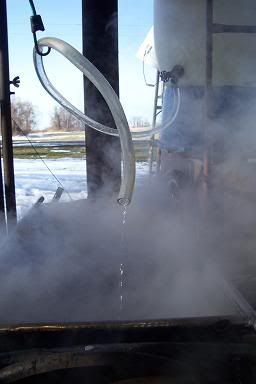
As the sap boils, dirty foam will collect on the surface. We skim it off with a wire mesh strainer, as shown in this next picture:
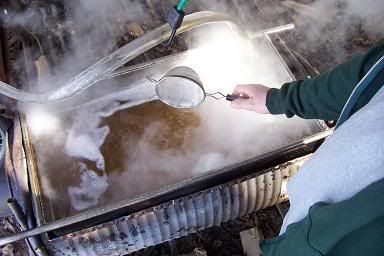
The sap will bubble and boil down for many hours as we keep the fire fed and fresh sap running in. We can typically boil down a whole barrel in a day. If the sap is “running” and we are refilling the barrel as we boil, we will sometimes leave the full pan with a fire underneath it and go to bed. In the morning the fire will be down to coals and ashes and the sap level will have steamed down two or three inches. Then we re-stoke the fire, top off the pan and boil for another day, or as long as needed to use up our sap supply. But we have never boiled a pan of syrup for more than two days because, the longer it boils, the darker it gets.
As the sap boils off and the sugar content concentrates, the boiling bubbles get smaller and smaller. When the syrup is almost done, the little bubbles will come together in foamy masses over the hottest part of the pan. A wood fire does not offer the control needed to precisely finish the syrup, so we draw it off just before it is completely done, and take it in the house to finish on the kitchen stove.
There is a certain knack to knowing when you’ve boiled far enough. Rink Mann’s book gives some pointers. The more we’ve made maple syrup, the better we’ve gotten at knowing the right time to draw off the evaporator’s contents. We will discuss when the time is right between ourselves: "It's not ready yet!" "Yes it is!" "No it's not!"
The problem is that the syrup can go from close-to-ready to overdone pretty fast. Overdone means that when the syrup cools down, the sugar will crystalize (not the desired outcome). Really overdone means you completely forgot about the evaporator pan long enough for the liquid to all boil off. It's a memorable experience.
There is, fortunately, a simple instrument that you can use to tell exactly when the syrup is close to done and just right. I'll show and tell about that in my next essay.
For our pan, and the amount of sap we process, we usually end up with a half inch of close-to-done syrup in the bottom, and it usually amounts to a couple gallons of liquid.
To draw the syrup off, we have three methods. One is to lift the pan off the firebox, set it over a sawhorse and open the ballvalve to let it flow into a big stockpot. It takes two people to do this and we are extremely careful about it because hot syrup is dangerous. I have a friend who spilled a pan of maple syrup on himself. The burns were bad enough to put him in the hospital and he was out of work for several weeks.
If I am by myself and have to draw off the syrup, I shovel out the hot coals and drain the pan. Or, on a couple of occasions, I’ve shoveled snow into the firebox to quench the fire before drawing off the syrup.
Sorry but I don’t have a picture of drawing off the syrup. But I have pictures of finishing it off on the stove in our kitchen and I will write about that next.
Stay tuned.....
Click Here to go on to Backyard Sugarin' Part 5: Finishing
or
CLICK HERE to go back to Part 1 of this Backyard Sugarin' series
 |
| CLICK HERE to check out the Wood family's "Sap to Syrup" DVD |























































































































2 comments:
You have such a nifty setup. I made maple syrup from my three trees one year. I got a little less than a quart of GOOD syrup. It was good only because I made it from my trees. It probably was not really all that good. I have permission from my neighbors to use their trees, but I have not done it again. Yet... You are inspiring me. :-D
Thank you for all the information. I tapped maples last winter and made a gallon of delicious syrup, but the evaporator set-up I made out of concrete blocks I gathered from around the homestead completely fell apart by the third and final boil!!! Our lasagna pans rested on grill grates over the firebox, and by the end they were so bowed and red-hot, I thought they would just break and dump the syrup in the fire! The pans were so hot, shifting them around and removing them for pour-off burnt through pair after pair of oven mitts!
I love the magic, but need to upgrade the methods.
I'm most curious about your metal barrel, as I would really like to copy your design for this year. What was originally in the barrel? Did you have to burn out the inside before using it?
Thanks again for sharing your projects with us,
Bethany
Post a Comment